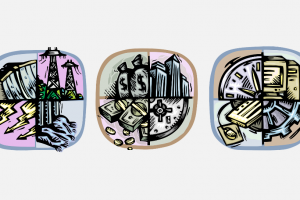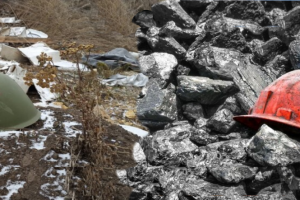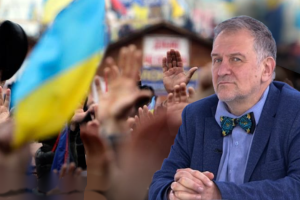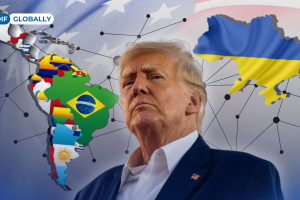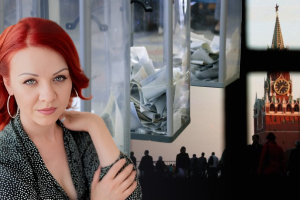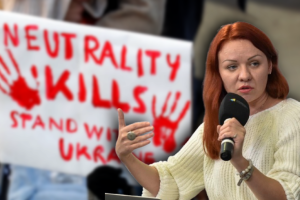Ukraine’s Long Road to European Integration (co-author: Maria Zolkina)
.jpg) Olexiy Haran,
Olexiy Haran,
Maria Zolkina
Different presidents have come to power in Ukraine under different foreign policy slogans, but none have been able to conduct a coherent foreign policy. Moreover, at one time or another, each of them—Leonid Kravchuk, Leonid Kuchma, Viktor Yushchenko, and Viktor Yanukovych—have issued formal declarations that state that European integration is Ukraine’s strategic goal. However, the need to deal with Russian economic and informational warfare has created recurring challenges and stumbling blocks for Ukraine’s leaders (as well as voters). We witnessed this trend once again in the leadup to the European Union’s Eastern Partnership (EaP) Summit in Vilnius in November 2013, when Yanukovych declined to sign the Ukraine-EU Association Agreement (AA). This caused massive pro-EU protests in Ukraine—the “Euromaidan,” named after the main square in Ukraine’s capital, the same place that had been the symbolic center of the 2004 Orange Revolution.
A Legacy of Multi-Vector Diplomacy
In the mid-1990s, former president Leonid Kuchma began a series of maneuvers to strengthen the Ukrainian state. He weakened separatist forces in Crimea, concluded a Treaty on Friendship, Cooperation, and Partnership with Russia, which finally recognized Ukraine’s borders, and even signed a NATO-Ukrainian Charter on a Distinctive Partnership in 1997.
But while Kuchma navigated between Russia and the West through a policy of multi-vector diplomacy, he ultimately moved cautiously in one direction – toward the West. While distancing himself from Kravchuk, whose policies the more Russified eastern Ukraine judged too nationalist, Kuchma had to take into consideration the position of those who had voted for Kravchuk in Ukraine’s western and central regions. In June 1998, Kuchma issued a decree that approved of a “Strategy for Ukraine’s Integration into the EU,” through first “association” and eventually full membership. Later, in 2003, the parliamentary faction of the Party of Regions (led by then-Prime Minister Viktor Yanukovych) unanimously voted for a “Law on Fundamentals of National Security in Ukraine,” which clearly stated that Ukraine’s aim was to join NATO and the EU.
This, however, could only take Kuchma so far. In the 2004 presidential elections, the Kuchma administration did everything possible to prevent Viktor Yushchenko from winning by presenting him as a radical nationalist who would “oppress” the Russian-speaking population. This stood in contrast to portrayals of candidate Yanukovych, who was positioned as “a great friend of Russia.“
One of the main reasons for Yushchenko’s success was that he used slogans that were common to the whole country and appealed to European values, social justice, rule of law, and the struggle with corruption. His emphasis on issues of social justice helped to overcome anti-Western stereotypes and the polarizing strategy of his opponents. In the end, however, the country emerged from the Orange Revolution extremely polarized.
The Yushchenko Era: Good Slogans, Mixed Results
For many years, Brussels refused to recognize Ukraine as a potential member of the EU. The most positive signal it sent to Kyiv was right after the Orange Revolution in January 2005, when the European Parliament passed a resolution on the results of Ukraine’s election, which proposed:
“…giving a clear European perspective for the country and responding to the demonstrated aspirations of the vast majority of the Ukrainian people, possibly leading ultimately to the country’s accession to the EU.” [emphasis by authors]
It also recalled:
“…the provisions of Article 49 of the Treaty on European Union, which state that EU membership is an option for all European countries that satisfy the relevant conditions and obligations; looks forward to a sustained transition process in Ukraine that would bring the country towards this objective, and commits itself to assisting and supporting Ukraine in this process.”
Even these formulations, however, were not developed in the subsequent EU-Ukraine Action Plan for 2005-2007, which had been prepared when Kuchma was still in power and many analysts in Brussels believed Yanukovych would succeed him.
Under President Yushchenko, Kyiv emphasized that its aim was to join the World Trade Organization, the EU, and NATO. It tried to prod the EU into action by abolishing visas to EU citizens. But Brussels, preoccupied with the French and Dutch vetos of the EU constitution, was not ready to send positive signals to Ukraine. After fifteen years of negotiations, Ukraine finally joined the WTO in 2008; the opposition Party of Regions, under Yanukovych’s leadership, joined all parliamentary factions with the exception of the Communists in voting to ratify Ukraine’s membership. Yushchenko also opened the way for negotiations on Ukraine’s AA with the EU, to include the establishment of a deep and comprehensive free trade area (DCFTA). His government also began negotiations to cancel visas for short-term visits of Ukrainians to the EU.
At the same time, contrary to his conduct in the 2004 campaign, Yushchenko divided society in the 2010 presidential campaign by spoiling relations with the Kremlin, openly supporting NATO membership, and glorifying anti-Soviet partisans from the World War II-era Organization of Ukrainian Nationalists. As a result, Yushchenko narrowed his already shrinking base and finished with just five percent of the vote. For his part, Yanukovych campaigned not only on the disappointment caused by the performance of the Orange government but also on alleged Western passivity, arguing that “if the EU does not want us, let us look to Russia.” He also exploited anti-Western sentiment. Thanks to the electoral rhetoric on both sides, Ukraine lapsed back into a polarized state.
Yanukovych, the AA, and Ukraine’s New Authoritarianism
Paradoxically, Brussels accelerated negotiations on an AA and visa-free regime only after the Orange forces lost the 2010 presidential election and Yanukovych began backsliding from democracy (including changing the constitution and using “politically selective justice,” as the EU formulated it, against his political opponents, chief among them former Prime Minister Yulia Tymoshenko). Brussels and Washington decided to engage the democratically-elected Yanukovych in political dialogue. After the “Orange chaos,” the West seemed happy that Ukraine was speaking with one voice and that its relations with Russia had improved. However, the West overlooked the nature of Yanukovych’s leadership. Only at the end of 2010 did the European Parliament express its first serious concerns about his authoritarian tendencies.
In July 2010, Yanukovych broke, to a certain extent, with Ukrainian foreign policy tradition. The Ukrainian parliament adopted a new law on the fundamentals of Ukraine’s foreign and domestic policy that excluded integration with NATO and established a policy of “non-alignment” aimed at appeasing the Kremlin. At the same time, the law emphasized that EU membership was still a priority. If successful, Yanukovych’s foreign policy could thus evolve from its initial pro-Russian overtures into a new version of Kuchma’s multi-vector policy.
Despite Yanukovych’s authoritarian leanings, the EU ultimately decided not to repeat the situation that occurred under Kuchma, when isolation from the West pushed the president back toward Russia. Ukrainian civil society and even Tymoshenko herself supported this position. After some hesitation, the EU decided to initial the AA in March 2012 but again wavered for almost a year. Finally, at the February 2013 EU-Ukraine summit, Brussels mentioned the possibility of signing an AA with Ukraine later in the year. However, Yanukovych took domestic political steps contrary to Brussels’ expectations and continued to maneuver between the EU and Russia.[1] The window of opportunity for signing the AA with the EU began to narrow.
In August 2013, Russian economic and psychological pressure on Ukraine, which included a temporary halt to all Ukrainian imports, appeared to push Brussels and Yanukovych toward each other. Directed by the presidential office, the Party of Regions began voting in September and October alongside the opposition to pass a set of so-called “Euro-integration laws” that were necessary for signing the AA. It also sought to convince the public of the advantages of EU integration.
Public Opinion and Foreign Policy
At first blush, Yanukovych’s new multi-vectorism is arguably supported by Ukrainians’ ambivalent geopolitical orientations: different polls have shown that the Ukrainian people tend to say “yes” to both the EU and the Customs Union with Russia, Belarus, and Kazakhstan. This ambivalence has helped Yanukovych use relations with the EU as a counterweight against Russia and vice-versa.
Nonetheless, Yanukovych’s tack toward Europe also had a popular justification. According to a May 2013 poll by the Democratic Initiatives Foundation (DIF) and the Razumkov Center, when given a choice, 42 percent of respondents favored entering the EU while 31 percent favored entering the Customs Union (see Table 1).
Table 1.
In which Direction of Integration Should Ukraine Move?
(“Give only one answer.”)
| West | Center | South | East | All of Ukraine |
Entering the EU | 72.2 | 48.8 | 32.9 | 20.7 | 41.7 |
Entering the Custom Union of | 7.4 | 21.9 | 39.5 | 50.4 | 31.0 |
Entering neither EU, nor the | 10.2 | 15.3 | 13.8 | 13.5 | 13.5 |
Difficult to say | 10.2 | 13.9 | 13.8 | 15.5 | 13.7 |
Source: DIF/ Razumkov Center (May 2013)
Unsurprisingly, half of respondents from eastern Ukraine and about 40 percent from southern Ukraine supported integration into the Customs Union. Since these regions are the main electoral bases for Yanukovych and the Party of Regions, this created a peculiar political situation for the ruling party as it had to explain to its voters why the government was opting for the EU (setting aside that such an intent was laid out in the PR’s programmatic documents). Therefore, by signing the AA, Yanukovych was not going to stop playing his multi-vector game, especially on the eve of the 2015 presidential election when he would need the votes of the electorate in the east and south.
At the same time, there was a significant undecided population that could be persuaded to support EU integration. The largest number of undecided happened to be in the east, at 15.5 percent, which meant that there was (and is) the potential to conduct a successful pro-EU informational campaign in this region. Yanukovych could also increase supporters in the center of the country by presenting himself as a potential promoter of Euro-integration. The number of those undecided was about the same in the center as in the south, at 14 percent. Considering the general trend of support for European integration in the center of the country, it is clear that if the Party of Regions worked at it, it would have been able to increase the number of Euro-integration proponents in this region as well. The fact that younger Ukrainians (18-29 years old) in all regions have a greater European orientation also attests to the possibility that Yanukovych could secure a Euro-majority. In the May 2013 survey, 54 percent of youth supported the EU, while those over 60 supported the Custom Union over the EU by 45 percent to 30 percent.
Decision Time
After enduring Russian pressure, Yanukovych hoped that the EU would take into account geopolitical considerations that would diminish the significance of the Tymoshenko case, which formally was considered as one of the key obstacles to signing the AA. The “Cox-Kwasniewski” mission of the European parliament came up with a compromise: the EU would not demand the full legal rehabilitation of Tymoshenko in exchange for her pardon by Yanukovych and permission to leave for medical treatment in Germany. Tymoshenko agreed, but Yanukovych ultimately consented only to a temporary stay in Germany for medical care. In the end, President Yanukovych tacked back toward the east before the Europeans could decide what to do. He decided to postpone signing the AA in Vilnius in November, cracked down on ensuing protests, and agreed to take Russian financial support, including a long-demanded discount on Russian gas, as compensation for his new policy.
Conclusion
Despite the fact that the goal of European integration is not viewed by a majority of Ukrainians as a vehicle that can become a “national idea,” developing relations with and integrating into the EU is still viewed by most in a “positive light.” Seventy-five percent of those polled by the DIF and the Razumkov Center from December 20-24, 2013, called the Euromaidan the most important event of the year. If Yanukovych had signed the AA with the EU, it could have created a favorable climate for forging a national consensus on EU integration on the eve of the 2015 presidential election. Unfortunately, the chance for this has been lost. Yanukovych now enters the campaign season polarizing society just as he did in 2004 and 2010. Such a tactic is risky, for both Yanukovych and Ukraine.

